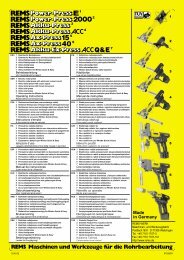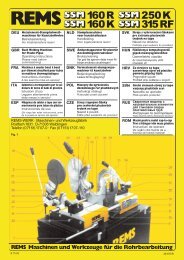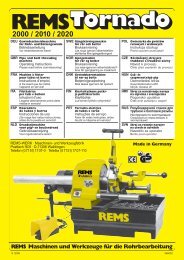pneumatic - Velkommen til REMS service
pneumatic - Velkommen til REMS service
pneumatic - Velkommen til REMS service
You also want an ePaper? Increase the reach of your titles
YUMPU automatically turns print PDFs into web optimized ePapers that Google loves.
GBR GBR<br />
Fig. 1–3<br />
1 Clamping screw with locking handle<br />
2 Guide bracket<br />
3 Mounting pin<br />
4 Blade thrust piece<br />
5 Saw blade<br />
Basic Safety Instructions<br />
6 Support shoe<br />
7 Switch trigger<br />
8 Overload protection<br />
9 Clamping screw<br />
10 Speed regulating switch<br />
11 Lever<br />
Warning! Read before commissioning!<br />
When using machines, electric tools and electric units – hereinafter referred to as<br />
"units" – basic safety precautions should always be followed to reduce the risk of<br />
electric shock, personal injury and fire, including the following.<br />
Read and comply with all these instructions before operating the unit. Save these<br />
safety instructions.<br />
Only use the unit for the purpose for which it was intended, with due attention to<br />
the general safety and accident prevention regulations.<br />
· Keep work area clean<br />
Cluttered areas invite injuries.<br />
· Consider work area environment<br />
Don't expose units to rain. Don't use in damp or wet locations. Keep work area<br />
well lit. Don't use power tools in presence of flammable liquids or gases.<br />
· Guard against electric shock<br />
Prevent body contact with earthed surfaces (e.g. pipes, radiators, ranges, refrigerators).<br />
If the unit comes with an earthed wire, the plug must only be connected<br />
to an earthed receptacle. At work sites, in the fields or any other comparable<br />
sites of use, the unit shall only be connected to the power supply with a 30mA<br />
fault current protected switch.<br />
· Keep children away<br />
Do not let contact unit or power lead. All bystanders should be kept away from<br />
work area. Only allow trained personnel to use it. Apprentices may only operate<br />
the machine when they are older than 16, when this is necessary for their<br />
training, and under the supervision of a trained operative.<br />
· Store idle units safely<br />
When not in use keep units in a dry place, either locked up or high up, out of<br />
reach of children.<br />
· Never overload a unit<br />
It will do the job better and safer at the rate for which it was intended. Replace<br />
tools in good time.<br />
· Use the right unit for the job<br />
Don't force small units to do the job of a heavy-duty tool. Don't use units for<br />
purposes not intended.<br />
· Dress properly<br />
Do not wear loose clothing or jewellery. They can be caught in moving parts.<br />
Rubber gloves and non-skid footwear are recommended when working outdoors.<br />
Wear protective hair covering to contain long hair.<br />
· Use personal safety equipment<br />
Wear safety goggles. Wear safety glasses. Wear ear defenders to protect<br />
against noise € 85 dB(A). Wear a face mask if work is dusty.<br />
· Don't abuse lead<br />
Never carry unit by lead or yank lead to disconnect from receptacle. Keep the<br />
lead away from heat, oil and sharp edges.<br />
· Keep hands away from moving (rotating) parts.<br />
· Secure workpiece<br />
Use clamps or a vice to hold workpiece. It's safer than using your hand and it<br />
frees both hands to operate the unit.<br />
· Don't overreach<br />
Keep proper footing and balance at all times.<br />
· Maintain units with care<br />
Keep tools sharp and clean for better and safer performance. Follow instructions<br />
for servicing and changing tools. Inspect unit leads periodically and, if damaged,<br />
have them repaired by an authorised <strong>service</strong> facility. Inspect extension leads<br />
periodically and replace them if damaged. Keep handles dry, clean and free<br />
from oil and grease.<br />
· Disconnect units from the power supply<br />
For all operations described under "Preparations for Use" and "Maintenance",<br />
when not in use, before servicing and when changing tools.<br />
· Remove keys and spanner<br />
Check if keys and adjusting tools are removed from unit before turning it on.<br />
· Avoid unintentional starting<br />
Don't carry plugged-in unit with finger on switch trigger. Be sure switch is turned<br />
off when plugging in. Do not bridge the inching switch.<br />
· Outdoor use extension leads<br />
When unit is used outdoors, use only extensions leads intended for use outdoors<br />
and so marked.<br />
· Stay alert<br />
Watch what you are doing. Use common sense. Do not operate unit when you<br />
are tired.<br />
· Check unit for damaged parts<br />
Before further use of the unit, a guard or other part that is damaged should be<br />
carefully checked to determine that it will operate properly and perform its<br />
intended function. Check for alignment of moving parts, binding of moving parts,<br />
breakage of parts, mounting, and any other condition that may affect the power<br />
tool's operation. A guard or other part that is damaged should be properly<br />
repaired or replaced by an authorised <strong>service</strong> facility unless otherwise indicated<br />
in the operating instructions. Have defective switches replace by an<br />
authorised <strong>service</strong> facility. Do not use the unit if the switch does not turn it on<br />
and off.<br />
· Warning<br />
Only use genuine spare parts and accessories, for personal safety reasons,<br />
to ensure correct operation of the machine. The use of other accessories or<br />
attachments involves a risk of injury.<br />
· Have your unit repaired by an authorised <strong>service</strong> facility<br />
This unit complies with the relevant safety. All maintenance and repair work,<br />
particularly when involving the electrical systems, must be performed only by<br />
specialist personnel or by persons familiar with the machine and by using original<br />
spare parts, otherwise injuries may result to the user. All unauthorised modifications<br />
of the machine are prohibited for safety reasons.<br />
Additional battery and charger safety rules<br />
· <strong>REMS</strong> tools use batteries containing nickel cadmium (NiCd) cells which can<br />
be charged many times to give long life and repeatedly full power.<br />
· The charger is designed for indoor use only, in dry and roofed areas.<br />
· Do not operate the charger if it has received a sharp blow, been dropped, or<br />
otherwise damaged in any way. Take it to a <strong>service</strong> centre.<br />
· Never attempt to connect two chargers together.<br />
· Do not charge your battery when it or the air temperature is below 5°C/40°F<br />
or above 40°C/105°F). This is important and may prevent serious damage to<br />
the battery.<br />
· Do not incinerate the battery even if it is severely damaged or completely worn<br />
out. The battery pack can explode in a fire. A small leakage of liquid from the<br />
battery cells may occur under extreme usage, charging or temperature conditions.<br />
This does not indicate a failure. However, if the outer seal is broken and<br />
this leakage gets on your skin:<br />
* Wash quickly with soap and water.<br />
* Neutralise with a mild acid such as lemon juice or vinegar.<br />
* If battery liquid gets into your eyes, flush them with clean water for a minimum<br />
of 10 minutes and seek immediate medical attention. (Medical note: The<br />
liquid is a 25–35% solution of potassium hydroxide.)<br />
· Ensure that the batteries metal end can not be shorted by other metal parts,<br />
such as screws, cutlery, nails etc.<br />
· Ensure that the batteries are charged using the recommended charger. Incorrect<br />
use may result in a risk of electric shock, overheating or leakage of corrosive<br />
liquid from the battery.<br />
· Do not attempt to recharge non-rechargeable batteries.<br />
Important!<br />
· To prolong battery life, avoid leaving the battery on charge for periods longer<br />
than two days. Although overcharging is not a safety concern, it can significantly<br />
reduce overall battery life.<br />
· When you charge your battery for the first time or after prolonged storage, it<br />
will only accept about an 80% charge. However, after several charges and discharge<br />
cycles, the battery will come up to full capacity.<br />
· Whilst charging, the charger and the energy pack may become warm to touch.<br />
This is a normal condition and does not indicate a problem. The energy pack<br />
should be recharged when it fails to produce sufficient power on jobs which<br />
were easily done previously. Do not continue to use under these conditions.<br />
Special Safety Instructions<br />
· Do not overload the saw and the saw blade. Do not use too high feed<br />
pressure.<br />
· Wear ear defenders.<br />
· Watch that no residual water runs into the motor while sawing lines caryingwater.<br />
Danger: electric shock.<br />
· On dusty work (with materials containing asbestos, stone etc.) comply<br />
with the accident prevention regulations.<br />
1. Technical Data<br />
1.1. Article numbers<br />
<strong>REMS</strong> Tiger ANC drive unit 560000<br />
<strong>REMS</strong> Tiger ANC <strong>pneumatic</strong> drive unit 560002<br />
<strong>REMS</strong> Cat ANC drive unit 560004<br />
<strong>REMS</strong> Akku-Cat ANC drive unit 560006<br />
<strong>REMS</strong> High-Power-Battery 18 V 565210<br />
Rapid-charger 12–18 V 565220<br />
1.2. Capacities<br />
Square sawing<br />
<strong>REMS</strong> Tiger ANC, <strong>REMS</strong> Tiger ANC <strong>pneumatic</strong><br />
With guide support 563000 and<br />
<strong>REMS</strong> special saw blade 561001<br />
Pipes (including plastic coated) up to 2”<br />
Metal, wood, plaster, etc. 3 mm and thicker<br />
With guide support 563100 and<br />
<strong>REMS</strong> special saw blade 561002<br />
Pipes (including plastic coated) up to 4”<br />
Metal, wood, plaster, etc. 3 mm and thicker<br />
With guide support 563100,<br />
electronic speed regulator 565051<br />
and <strong>REMS</strong> universal saw blade 561003<br />
Stainless steel pipes (INOX) up to 4”<br />
Metal, wood, plastic 1.5 mm and thicker<br />
Hand-held sawing<br />
<strong>REMS</strong> Tiger ANC, <strong>REMS</strong> Tiger ANC <strong>pneumatic</strong>, <strong>REMS</strong> Cat ANC, <strong>REMS</strong><br />
Akku-Cat ANC<br />
<strong>REMS</strong> universal saw blade and<br />
<strong>REMS</strong> saw blades (see 1.1. and 2.4.) Metal up to 20 mm<br />
1.3.Number of strokes<br />
Wood up to 160 mm<br />
<strong>REMS</strong> Tiger ANC (idling speed) 2200 rpm<br />
<strong>REMS</strong> Tiger ANC 48 V (idling speed) 1300 rpm<br />
<strong>REMS</strong> Tiger ANC <strong>pneumatic</strong> (idling speed) 1700 rpm<br />
<strong>REMS</strong> Cat ANC (infinitely variable) 0 ... 2200 rpm<br />
<strong>REMS</strong> Akku-Cat ANC (infinitely variable) 0 ... 1700 rpm






